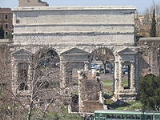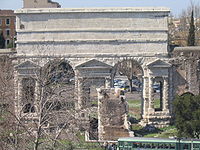
Porta Maggiore
Encyclopedia

Aurelian Walls
The Aurelian Walls is a line of city walls built between 271 and 275 in Rome, Italy, during the reign of the Roman Emperors Aurelian and Probus....
of Rome
Rome
Rome is the capital of Italy and the country's largest and most populated city and comune, with over 2.7 million residents in . The city is located in the central-western portion of the Italian Peninsula, on the Tiber River within the Lazio region of Italy.Rome's history spans two and a half...
.
Through the gate ran two ancient roads: the Via Praenestina
Via Praenestina
The Via Praenestina was an ancient Roman road of central Italy.It was initially called Via Gabina, from Gabii, the ancient city of Latium where it ended...
and the Via Labicana
Via Labicana
The Via Labicana was an ancient road of Italy, leading east southeast from Rome. It seems possible that the road at first led to Tusculum, that it was then extended to Labici, and later still became a road for through traffic; it may even have superseded the Via Latina as a route to the southeast,...
. The Via Prenestina was the eastern road to the ancient town of Praeneste (modern Palestrina
Palestrina
Palestrina is an ancient city and comune with a population of about 18,000, in Lazio, c. 35 km east of Rome...
). The Via Labicana (now called the Via Casilina) heads southeast from the city.
The gate
The Porta Maggiore is by far the best urban site to visit for an understanding and view of the ancient aqueducts. It is a monumental double archway built of white travertineTravertine
Travertine is a form of limestone deposited by mineral springs, especially hot springs. Travertine often has a fibrous or concentric appearance and exists in white, tan, and cream-colored varieties. It is formed by a process of rapid precipitation of calcium carbonate, often at the mouth of a hot...
(a type of limestone). It was first known as the Porta Prenestina, perhaps a reference to the road over which is passes (the Via Praenestina). The "gate," built in 52 by the emperor Claudius, was originally intended to provide a decorative section of support for two aqueducts, the Aqua Claudia
Aqua Claudia
Aqua Claudia was an aqueduct of ancient Rome that, like the Anio Novus, was begun by emperor Caligula in 38 AD and completed by Emperor Claudius in 52 AD. Its main springs, the Caeruleus and Curtius, were situated 300 paces to the left of the thirty-eighth milestone of the Via Sublacensis...
and the Anio Novus
Anio Novus
Anio Novus is an aqueduct of Rome. Together with the Aqua Claudia, it was begun by emperor Caligula in 38 AD and completed in 52 AD by Claudius, who dedicated them both on August 1.-Details:...
. At that time these aqueducts crossed the ancient Via Labicana and Praenestina roads thereby providing the opportunity to create at this location a sort of triumphal arch to the conquest of nature and its conqueror, the emperor Claudius. The two channels of these aqueducts, (the Aqua Claudia and Aqua Anio Novus), one lying on top of the other, can be seen in cross-section running through the travertine attic at the top of the gate (see illustration above).
It contains inscriptions in praise of the emperors Claudius, Vespasian
Vespasian
Vespasian , was Roman Emperor from 69 AD to 79 AD. Vespasian was the founder of the Flavian dynasty, which ruled the Empire for a quarter century. Vespasian was descended from a family of equestrians, who rose into the senatorial rank under the Emperors of the Julio-Claudian dynasty...
, and Titus
Titus
Titus , was Roman Emperor from 79 to 81. A member of the Flavian dynasty, Titus succeeded his father Vespasian upon his death, thus becoming the first Roman Emperor to come to the throne after his own father....
for their work on the aqueducts. These are set out below.
The gate was incorporated in the Aurelian Wall in 271 by the emperor Aurelian
Aurelian
Aurelian , was Roman Emperor from 270 to 275. During his reign, he defeated the Alamanni after a devastating war. He also defeated the Goths, Vandals, Juthungi, Sarmatians, and Carpi. Aurelian restored the Empire's eastern provinces after his conquest of the Palmyrene Empire in 273. The following...
thus truly turning it into an entrance (gate) to the city. Experts refer to this as an early example of “architectural recycling,” essentially adapting one existing structure, to another use. In this case using an aqueduct as a wall.
It was modified further when the emperor Honorius
Honorius (emperor)
Honorius , was Western Roman Emperor from 395 to 423. He was the younger son of emperor Theodosius I and his first wife Aelia Flaccilla, and brother of the eastern emperor Arcadius....
augmented the walls in 405. The foundations of a guardhouse added by Honorius are still visible, while the upper part of the gate, as built by Honorius, has been moved to the left side of the Porta.
It is currently known as the Porta Maggiore, possibly designated as such because of the road that runs through the gate leads to the Basilica di Santa Maria Maggiore. The church is an important place of prayer dedicated to the Virgin Mary.
The following inscriptions are prominently displayed on the attic of the Porta Maggiore:
TI. CLAUDIUS DRUSI F. CAISAR AUGUSTUS GERMANICUS PONTIF. MAXIM., / TRIBUNICIA POTESTATE XII, COS. V, IMPERATOR XXVII, PATER PATRIAE, / AQUAS CLAUDIAM EX FONTIBUS, QUI VOCABANTUR CAERULEUS ET CURTIUS A MILLIARIO XXXXV, / ITEM ANIENEM NOVAM A MILLIARIO LXII SUA IMPENSA IN URBEM PERDUCENDAS CURAVIT.
([In AD 52] the Emperor Claudius [etc.] had the waters of the Claudia brought to Rome from the springs called Caeruleus and Curtius at the 45th milestone, and likewise the Anio Novus from the 62nd milestone, both at his own expense.)
IMP. CAESAR VESPASIANUS AUGUST. PONTIF. MAX. TRIB. POT. II IMP. VI COS. III DESIG. IIII P. P. / AQUAS CURTIAM ET CAERULEAM PERDUCTAS A DIVO CLAUDIO ET POSTEA INTERMISSAS DILAPSASQUE / PER ANNOS NOVEM SUA IMPENSA URBI RESTITUIT.
([In AD 71] the Emperor Vespasian [etc.] restored to the city at his own expense the Curtian and Caerulean waters, which had been led to the city by the deified Claudius but had fallen into intermittent use and disrepair for nine years.)
IMP. T. CAESAR DIVI F. VESPASIANUS AUGUSTUS PONTIFEX MAXIMUS TRIBUNIC. / POTESTATE X IMPERATOR XVII PATER PATRIAE CENSOR COS. VIII / AQUAS CURTIAM ET CAERULEAM PERDUCTAS A DIVO CLAUDIO ET POSTEA / A DIVO VESPASIANO PATRE SUO URBI RESTITUTAS CUM A CAPITE AQUARUM A SOLO VETUSTATE DILAPSAE ESSENT NOVA FORMA REDUCENDAS SUA IMPENSA CURAVIT.
([In AD 81] the Emperor Titus [etc.] at his own expense, had the Curtian and Caerulean waters, introduced by the deified Claudius and afterwards repaired for the city by Titus’s deified father Vespasian, restored with new structures, beginning from its source, after the aqueduct was ruined to its foundations from age.)
Nearby archaeological remains
Close by the gate, just outside the wall, is the unusual Tomb of the BakerTomb of Eurysaces the Baker
The tomb of Marcus Vergilius Eurysaces the baker is one of the largest and most well preserved freedmen funerary monuments in Rome. Its sculpted friezes are classic exemplars of the "plebeian style" in Roman sculpture, which was eventually to overwhelm the Greek influenced style of the Imperial court...
, built by Marcus Virgilius Eurysaces.
In 1915, a subterranean Neopythagorean
Neopythagoreanism
Neopythagoreanism was a Graeco-Alexandrian school of philosophy, reviving Pythagorean doctrines, which became prominent in the 1st and 2nd centuries CE...
basilica
Basilica
The Latin word basilica , was originally used to describe a Roman public building, usually located in the forum of a Roman town. Public basilicas began to appear in Hellenistic cities in the 2nd century BC.The term was also applied to buildings used for religious purposes...
was discovered nearby on the Via Praenestina, dating from the 1st century. The groundplan shows three naves and an apse, a design similar to that which began to be adopted in Christian basilicas during the 4th century. The vaults are decorated with white stuccoes symbolizing Neopythagorean beliefs, although the precise meaning of elements of the decoration remains a subject of debate.

